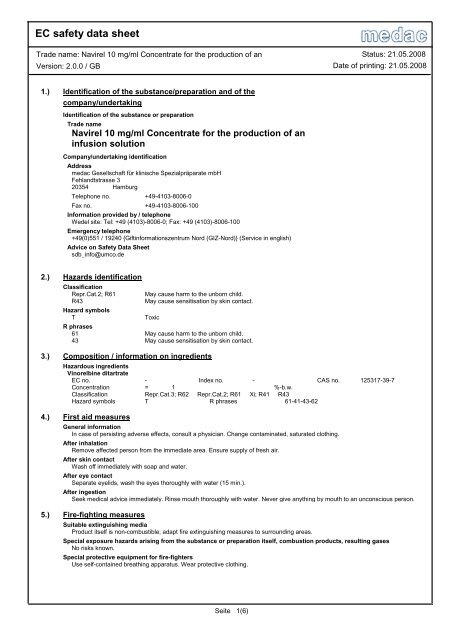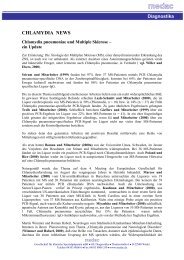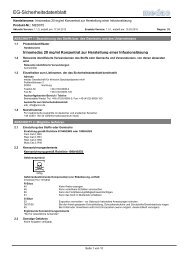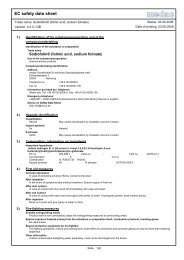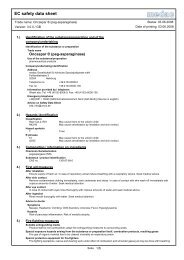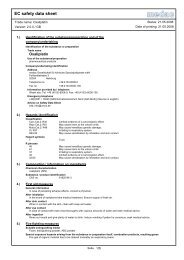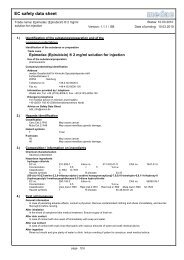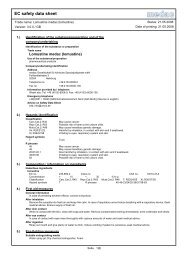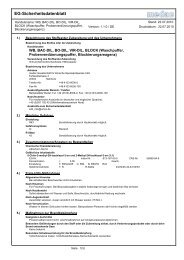Navirel - medac GmbH
Navirel - medac GmbH
Navirel - medac GmbH
You also want an ePaper? Increase the reach of your titles
YUMPU automatically turns print PDFs into web optimized ePapers that Google loves.
EC safety data sheet<br />
Trade name: <strong>Navirel</strong> 10 mg/ml Concentrate for the production of an<br />
Version: 2.0.0 / GB<br />
1.) Identification of the substance/preparation and of the<br />
company/undertaking<br />
Identification of the substance or preparation<br />
Trade name<br />
<strong>Navirel</strong> 10 mg/ml Concentrate for the production of an<br />
infusion solution<br />
Company/undertaking identification<br />
Address<br />
<strong>medac</strong> Gesellschaft für klinische Spezialpräparate mbH<br />
Fehlandtstrasse 3<br />
20354 Hamburg<br />
Telephone no. +49-4103-8006-0<br />
Fax no. +49-4103-8006-100<br />
Information provided by / telephone<br />
Wedel site: Tel: +49 (4103)-8006-0; Fax: +49 (4103)-8006-100<br />
Emergency telephone<br />
+49(0)551 / 19240 {Giftinformationszentrum Nord (GIZ-Nord)} (Service in english)<br />
Advice on Safety Data Sheet<br />
sdb_info@umco.de<br />
2.) Hazards identification<br />
Classification<br />
Repr.Cat.2; R61 May cause harm to the unborn child.<br />
R43 May cause sensitisation by skin contact.<br />
Hazard symbols<br />
T Toxic<br />
R phrases<br />
61 May cause harm to the unborn child.<br />
43 May cause sensitisation by skin contact.<br />
3.) Composition / information on ingredients<br />
Seite 1(6)<br />
Status: 21.05.2008<br />
Date of printing: 21.05.2008<br />
Hazardous ingredients<br />
Vinorelbine ditartrate<br />
EC no. - Index no. - CAS no. 125317-39-7<br />
Concentration = 1 %-b.w.<br />
Classification Repr.Cat.3; R62 Repr.Cat.2; R61 Xi; R41 R43<br />
Hazard symbols T R phrases 61-41-43-62<br />
4.) First aid measures<br />
General information<br />
In case of persisting adverse effects, consult a physician. Change contaminated, saturated clothing.<br />
After inhalation<br />
Remove affected person from the immediate area. Ensure supply of fresh air.<br />
After skin contact<br />
Wash off immediately with soap and water.<br />
After eye contact<br />
Separate eyelids, wash the eyes thoroughly with water (15 min.).<br />
After ingestion<br />
Seek medical advice immediately. Rinse mouth thoroughly with water. Never give anything by mouth to an unconscious person.<br />
5.) Fire-fighting measures<br />
Suitable extinguishing media<br />
Product itself is non-combustible; adapt fire extinguishing measures to surrounding areas.<br />
Special exposure hazards arising from the substance or preparation itself, combustion products, resulting gases<br />
No risks known.<br />
Special protective equipment for fire-fighters<br />
Use self-contained breathing apparatus. Wear protective clothing.
EC safety data sheet<br />
Trade name: <strong>Navirel</strong> 10 mg/ml Concentrate for the production of an<br />
Version: 2.0.0 / GB<br />
6.) Accidental release measures<br />
Seite 2(6)<br />
Status: 21.05.2008<br />
Date of printing: 21.05.2008<br />
Personal precautions<br />
Refer to protective measures listed in sections 7 and 8. Ensure adequate ventilation. Cordon and mark contaminated area.<br />
Personal protection equipment for removal of unintentional contamination or in the event of rupture :<br />
- Overshoes<br />
- liquid-proof protective long-sleeved coat with close-fitting sleeve-band<br />
- protective goggles<br />
- protective gloves<br />
- Protective face mask min. P2 according to the provisions of the professional organisation "Rules for use of breathing<br />
apparatuses"<br />
- cut cellulose in sufficient quantity<br />
- receptacle and waste container, shovel<br />
Environmental precautions<br />
Do not discharge into the drains/surface waters/groundwater. Do not allow to enter drains or waterways.<br />
Methods for cleaning up/taking up<br />
Kittake-up of liquid drugs spill:<br />
cover contaminated area carefully using disposable cloths or cellulose, so that the liquid is completely absorbed.<br />
take-up of dry solid matters:<br />
cover with several layers of cellulose contaminated area carefully over its whole surface, so that the cellulose can be wetted<br />
cautiously from above.<br />
; Take-up of glass breakage:<br />
Use of suitable means and use of an additional pair of protective gloves.<br />
Clean thoroughly contaminated areas. Remove immediately and appropriately soiling. Keep ready a decontamination kit. Take-up<br />
of liquid drugs spill.<br />
Cover contaminated area carefully using disposable cloth or cellulose, so that the liquid is completely absorbed.<br />
Take-up of dry solid matters.<br />
Cover with several layers of cellulose contaminated area carefully over its whole surface, so that the cellulose can be wetted<br />
cautiously from above.<br />
Take-up of glass breakage.<br />
Use of suitable means and use of an additional pair of protective gloves.<br />
Clean thoroughly contaminated areas.<br />
Additional informations (chapter 6)<br />
cytostatic substances can be inactivated according to the Barth procedure ruling the chemist’s (drugstore) production of cytostatics<br />
(chapter II-6, page 2-3).<br />
7.) Handling and storage<br />
Handling<br />
Advice on safe handling<br />
No special measures necessary if stored and handled as prescribed. Avoid formation of aerosols. [P_ID:8015380!]<br />
Advice on protection against fire and explosion<br />
No special measures necessary.<br />
Storage<br />
Requirements for storage rooms and vessels<br />
Store product in closed containers.<br />
Advice on storage assembly<br />
None known<br />
Further information on storage conditions<br />
Keep container tightly closed. Keep in a cool place.<br />
8.) Exposure controls / personal protection<br />
Exposure limit values<br />
N O N E<br />
Exposure controls<br />
Occupational exposure controls<br />
Handling of cytostatics / virusstatics calls always for separated, clearly marked working spaces in compliance with TRGS 525<br />
(technical provisions for hazardous substances).<br />
Personal protective equipment<br />
Respiratory protection<br />
If workplace exposure limits are exceeded, a respiration protection approved for this particular job must be worn. If ventilation<br />
insufficient, use a respiratory protection apparatus.<br />
Respiratory filter (part): min. P2<br />
Hand protection<br />
In case of intensive contact, wear protective gloves (EN 374). Sufficient protection is given wearing suitable protective gloves<br />
checked according to i.e. EN 374, in the event of risk of skin contact with the product . Before use, the protective glove should be<br />
tested in any case for its specific work-station suitability (i.e. mechanical resistance, product compatibility and antistatic properties).
EC safety data sheet<br />
Trade name: <strong>Navirel</strong> 10 mg/ml Concentrate for the production of an<br />
Version: 2.0.0 / GB<br />
Seite 3(6)<br />
Status: 21.05.2008<br />
Date of printing: 21.05.2008<br />
Adhere to the manufacturer’s instructions and information relating to the use, storage, care and replacement of protective gloves.<br />
Protective gloves shall be replaced immediately when physically damaged or worn. Design operations thus to avoid permanent<br />
use of protective gloves. Disposable gloves with long gauntlet and, if possible, revolving sleeve made of natural Latex, PVC or<br />
synthetics with tight closing band around the gauntlet (i.e. Biogel®Standard; Biogel®Skinsense or Biogel®Indicator)<br />
- unpowdered, poor protein content, close-fitting, firm surface<br />
- quality requirements according to DIN EN 374<br />
- finger area designed with double wall thickness<br />
- advantageous: dyed glovesrecommendation<br />
- Wearing of two pairs of gloves (i.e. Biogel®Indicator); According to TRGS 525 cytostatics protective gloves must be<br />
changed every 30 minutes.<br />
Material thickness > 0,02 mm<br />
Eye protection<br />
Safety glasses (EN 166); Safety glasses with side protection shield (EN 166)<br />
Skin protection<br />
Clothing as usual in the chemical industry. Liquid-proof protective long-sleeved coat with close-fitting sleeve-band obligatory.<br />
General protective and hygiene measures<br />
Do not eat, drink or smoke during work time. Keep away from foodstuffs and beverages. Wash hands before breaks and after work.<br />
Have eye wash fountain available. Do not inhale dust. An antechamber equipped with separated storage facilities must exist for<br />
changing (protective clothes and normal clothes) before the working space (lock). At work do not eat, drink, smoke or take drugs.<br />
Keep separated from food-stuffs and feed-stocks.<br />
9.) Physical and chemical properties<br />
General information<br />
Form liquid<br />
Colour clear<br />
Odour odourless<br />
10.) Stability and reactivity<br />
Conditions to avoid<br />
None, if handled according to order.<br />
Materials to avoid<br />
None known<br />
Hazardous decomposition products<br />
No hazardous decomposition products known.<br />
Thermal decomposition<br />
Remarks No decomposition if used as prescribed.<br />
11.) Toxicological information<br />
Acute toxicity<br />
Acute oral toxicity<br />
Remarks No data available.<br />
Acute dermal toxicity<br />
Remarks No data available.<br />
Acute inhalational toxicity<br />
Remarks No data available.<br />
Acute toxicity / further data<br />
TDLo 2 mg/kg<br />
Species rat<br />
Route of exposure i.v.<br />
Reference substance Vinorelbine tatrate<br />
Source RTECS<br />
Irritant/corrosive effects<br />
Irritant effect on eyes<br />
Reference substance Vinorelbine tatrate<br />
Evaluation irritant - risk of strong eye injuries<br />
Sensitisation<br />
Evaluation sensitizing
EC safety data sheet<br />
Trade name: <strong>Navirel</strong> 10 mg/ml Concentrate for the production of an<br />
Version: 2.0.0 / GB<br />
Effects after repeated or prolonged exposition (subacute, subchronic, chronic)<br />
Mutagenicity<br />
Type of examination Specific locus test<br />
Route of exposure oral<br />
Reference substance Vinorelbine tatrate<br />
Species Drosophila melanogaster<br />
Duration of exposure 48 h<br />
Administration 0,0001 mmol/l<br />
Value positive<br />
Seite 4(6)<br />
Status: 21.05.2008<br />
Date of printing: 21.05.2008<br />
Reproduction toxicity<br />
Remarks Indications of toxic effects are available from reproduction studies in animals.<br />
Carcinogenicity<br />
Remarks No data available.<br />
Experience in practice<br />
Liver and Kidney damage is possible.<br />
12.) Ecological information<br />
Ecotoxicity<br />
Fish toxicity<br />
Remarks No data available.<br />
Daphnia toxicity<br />
Remarks No data available.<br />
Algae toxicity<br />
Remarks No data available.<br />
Bacteria toxicity<br />
Remarks No data available.<br />
Other adverse effects<br />
Do not discharge product unmonitored into the environment.<br />
13.) Disposal considerations<br />
Product<br />
Cytostatic remainders as well as with cytostatics contaminated materials can form both with preparation and with application.<br />
During formulation various quantities of following materials are produced:<br />
• residues of concentrated solutions of cytostatic agent (injections)<br />
• residues of diluted solutions (infusions, instillations)<br />
• empty material (original receptacles, syringes)<br />
• auxiliary means for formulation/preparation (cannula, swabs, pads, gloves etc.)<br />
Following waste materials are produced when used:<br />
• empty material (syringes, infusion receptacles)<br />
• cytostatic residues from injections, that have not been completely consumed<br />
• injection residues in hoses, infusion sets, unemptied bags/bottles of infusion<br />
Note:<br />
Collect waste material separately in suitable waste containers where produced (on cytostatic workbench in pharmacy, during<br />
preparation of administration, in the treatment room) and prepare for in-house transport.<br />
The legal provisions relating to waste of the respective state must be adhered to.<br />
German Federal States follow the so-called “Guidelines ruling the correct disposal of waste from health service facilities” issued by<br />
the Working Group of the Federal States on Waste (LAGA).<br />
Following cytostatic waste materials must be disposed of as hazardous waste (“special waste”):<br />
• original receptacles that are not completely emptied such as cytostatics resulting from discontinued therapy or unintended use<br />
• decayed CMR drugs in original packing<br />
• residues of dry substances and broken tablets<br />
• syringe barrel and infusion bottles / bags with visible filling level/residual contents (> 20 ml)<br />
• Infusions systems and other cytostatics contaminated material (> 20 ml)<br />
• material that has been evidently contaminated through spillage of large quantities of liquids or solids during preparation or use of<br />
the aforementioned drugs (i.e. pads, strongly contaminated individual protective equipment).<br />
Such waste needs to be collected in pedal bins or waste containers with an opening mechanism in order to avoid any direct contact<br />
of hands/gloves with the waste.<br />
According to the legal provisions relating to hazardous goods and waste, such waste needs to be placed in appropriate, airtight<br />
and sound containers for disposal at a special facility displaying the following information: “AS 18 0108* – Cytotoxic and cytostatic<br />
waste” and the proper UN No. (pls. see below) according to the Transport of Dangerous Goods Regulations.
EC safety data sheet<br />
Trade name: <strong>Navirel</strong> 10 mg/ml Concentrate for the production of an<br />
Version: 2.0.0 / GB<br />
Seite 5(6)<br />
Status: 21.05.2008<br />
Date of printing: 21.05.2008<br />
The ADR label No 6.1 (Symbol „skull and crossbones“) shall be always affixed to the disposal containers. According to the<br />
regulation on hazardous substances Gefahrstoffverordnung (GefStoffV) disposal containers containing cytostatics labelled with<br />
the ADR label No 6.1 need no additional labelling (hazard symbol T, skull and crossbones on an orange background).<br />
Cytostatic waste disposed of under the waste name “AS 18 0108* – Cytotoxic and cytostatic waste” shall be provided with one of<br />
the following UN No.:<br />
• UN 2810 “TOXIC LIQUID, ORGANIC, N.O.S.“: Suitable for liquid cytostatics residues. In case of low liquid quantities, the<br />
packaging must only comply with the requirements of the Packaging group III.<br />
• UN 2811 „TOXIC SOLID ORGANIC, N.O.S.“: Suitable for sold cytostatic residues (i.e. broken tablets) and strongly contaminated<br />
materials.<br />
• UN 3243 „SOLIDS CONTAINING TOXIC LIQUID, N.O.S.“: Can be used as an alternative to UN 2810 and UN 2811.<br />
Usually following low-contaminated waste does not fall under the scope of the aforementioned group of hazardous waste:<br />
• gauntlets<br />
• gloves<br />
• face masks<br />
• single-use lab coats<br />
• swabs<br />
• wipes<br />
• empty cytostatics containers after intended use (ampoules, syringes, infusion accessories, infusion receptacles)<br />
• air filters from safety workbenches<br />
Low contaminated cytostatic waste shall be collected in airtight, plastic bags before final disposal immediately at the point of origin.<br />
They are disposed of using the official code and name “AS 18 01 04 – Wastes whose collection and disposal is not subject to<br />
special requirements in order to prevent infection (for example dressings, plaster casts, linen, disposable clothing, diapers)”. They<br />
may be disposed of together with hospital waste (former B waste). Sharp or pointed objects such as cannula, transfer cannula,<br />
spikes and cullets shall be collected at the point of waste origin, in puncture resistant and safely closed containers (i.e. sharps bin).<br />
When disposing of waste that is containing cytostatics, the provisions of the respective local waste regulation must be adhered to<br />
(i.e. does exist a duty to offer to an official buyer).<br />
14.) Transport information<br />
Other information (chapter 14.)<br />
The product is not defined under national/international road, rail, sea and air dangerous good transport regulations as a hazardous<br />
material.<br />
Containerise cytostatics only in unbreakable, liquid-proof and tightly closed containers.<br />
Marking of transport containers:<br />
Name and address of patient or surgery or hospital ward<br />
if necessary label: „Caution cytostatics“<br />
if necessary label:„refrigerated ware“<br />
if necessary label:„Caution breakable glass“,and instructions for the event of breakage<br />
Heat-sealing of primary containers recommended.<br />
15.) Regulatory information<br />
Labelling in accordance with EC directives<br />
The product is classified and labelled in accordance with EC Directive 1999/45/EC.<br />
Hazard symbols<br />
T Toxic<br />
Hazardous component(s) to be indicated on label, contains:<br />
Vinorelbine ditartrate<br />
R phrases<br />
61 May cause harm to the unborn child.<br />
43 May cause sensitisation by skin contact.<br />
S phrases<br />
53 Avoid exposure --- obtain special instructions before use.<br />
24 Avoid contact with skin.<br />
45 In case of accident or if you feel unwell, seek medical advice immediately (show the label where<br />
possible).<br />
Special labelling for certain preparations<br />
"Restricted to professional users"<br />
Restriction of occupation<br />
Observe employment restrictions for child bearing mothers and nursing mothers.<br />
Observe employment restrictions for young people.<br />
16.) Other information<br />
Further information<br />
Processing notes Please read packing specification of the drug for additional drug related information.<br />
The data of this safety data sheet reflect the actual state of knowledge. The safety data sheet describes the product in view of its<br />
handling and safety relevant requirements of the pharmaceutical ingredient as bulk ware (chemical).<br />
The information is based on our current knowledge however it does not represent a guarantee of product properties nor does it<br />
create any legal obligation.
EC safety data sheet<br />
Trade name: <strong>Navirel</strong> 10 mg/ml Concentrate for the production of an<br />
Version: 2.0.0 / GB<br />
Seite 6(6)<br />
Status: 21.05.2008<br />
Date of printing: 21.05.2008<br />
Sources of key data used to compile the data sheet:<br />
EC Directive 67/548/EC resp. 99/45/EC as amended in each case.<br />
Regulation (EC) No 1907/2006 (REACH) as amended in each case.<br />
EC Directives 2000/39/EC, 2006/15/EC as amended in each case.<br />
National Threshold Limit Values of the corresponding countries as amended in each case.<br />
Transport regulations according to ADR, RID, IMDG, IATA as amended in each case.<br />
The data sources used to determine physical, toxic and ecotoxic data, are indicated directly in the corresponding chapter.<br />
Relevant R-phrases (chapter 3):<br />
41 Risk of serious damage to eyes.<br />
43 May cause sensitisation by skin contact.<br />
61 May cause harm to the unborn child.<br />
62 Possible risk of impaired fertility.<br />
Department issuing safety data sheet<br />
UMCO Umwelt Consult <strong>GmbH</strong><br />
Georg-Wilhelm-Str. 183 b, D-21107 Hamburg<br />
Tel.: +49 40 / 41 92 13 00 Fax: +49 40 / 41 92 13 57 e-mail: umco@umco.de<br />
Ready-made medical preparations are not ruled by the chemical’s act, so that the submission of a safety data sheet is not<br />
obligatory. Medac, however, opts for this form because the safety data sheet constitutes a reliable source of information regarding<br />
the handling of hazardous substances and preparations, and because many occupational safety measures are basing on the<br />
safety data sheet structure.


